
Nike Case Study

Introduction:
Nike’s journey began in the 1950s when track coach Bill Bowerman, seeking an edge for his runners, experimented with various shoe designs but faced challenges in finding manufacturers willing to try his ideas. In 1955, Phil Knight, a runner under Bowerman at the University of Oregon, proposed importing quality yet affordable shoes from Japan. This idea led to the establishment of Blue Ribbon Sports in 1964, with Knight and Bowerman as partners. The company initially distributed Japanese Tiger shoes in the US. As Bowerman improved shoe designs, Knight focused on sales.
In 1971, Jeff Johnson joined as the first full-time employee, handling marketing and store operations. The company’s partnership with the Japanese supplier faltered, leading Knight and Bowerman to venture into designing and manufacturing their shoes. The iconic swoosh logo was introduced, and in 1972, the Nike line debuted during the US Track and Field Trials, impressing athletes with its innovative designs, including waffle-like soles and lightweight construction.
Nike sought athletes like Steve Prefontaine to endorse its products, and by 1980, the company went public. Despite leadership changes, Nike faced industry challenges in the mid-1980s until Michael Jordan’s endorsement revitalized the brand. The iconic “Just Do It” slogan was launched in 1988, followed by successful campaigns featuring athletes like Bo Jackson.
In the 1990s, Nike expanded into new sports, including soccer and golf, signing deals with teams like Brazil’s national soccer team. Criticized for signing Tiger Woods, Nike’s investment paid off when Woods won the 1997 Masters. In 2000, Nike introduced the Shox shoe, representing years of dedication and innovation.
Today, Nike remains a dominant force in the industry, continuously expanding its global presence and product offerings. With a rich history of innovation and iconic marketing campaigns, Nike continues to shape the future of sportswear.
World’s Shoe Market
In 2020, the global footwear market was valued at 365.5 billion USD and was predicted to reach approximately 530.3 billion USD by 2027. Exhibit 1 illustrates the trajectory of the footwear market worldwide from 2020 to 2027. Reebok, Adidas, Puma, and Under Armour are prominent players in this industry. Embracing a lifestyle centered around health and fitness has become a widespread trend across various consumer demographics globally. Many shoe manufacturers are collaborating with fashion designers to introduce new clothing lines, thereby expanding their product offerings in pursuit of growth and profitability. Consumption patterns are influenced by fitness and fashion trends, as well as specific demographic demands, such as those from teenagers and baby boomers.
Although India and China boast the largest populations and are witnessing a surge in fitness trends, they are considered significant shoe markets globally. However, Nike continues to generate its highest sales from North America and European nations. This can be attributed to the fact that India and China are still developing economies with predominantly unorganized shoe markets catering to local needs. While these countries are the primary focus markets for many global brands, they lack a substantial market for premium or specialized athletic footwear, contributing to this phenomenon.
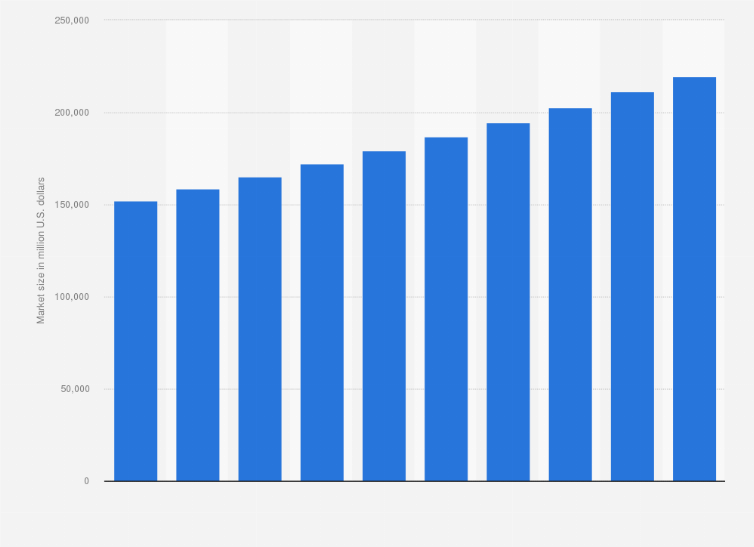
Nike’s Presence in the World Market
Nike, Inc., a renowned sportswear and equipment company headquartered in the United States, holds the title of the world’s largest producer of athletic shoes and gear. It boasts a diverse portfolio, not only manufacturing and selling athletic footwear but also significant sports equipment. Nike stands as the global leader in athletic footwear and gear, acquiring various footwear and apparel firms like Cole Haan, Bauer Hockey, Converse, Hurley International, Starter, and Umbro. Traded on the New York Stock Exchange (NYSE) under the symbol NKE, Nike’s iconic swoosh logo is not only one of the most recognizable trademarks globally but also among the most prominent athletic sponsors.
In 2021, Nike’s workforce numbered approximately 73,000 employees, with over 1,000 retail stores worldwide. The company’s success can be attributed to its robust global marketing campaigns, often involving sponsorship agreements with celebrities, professional sports teams, and collegiate athletic programs. Through these partnerships, Nike effectively promotes its technology and design across its products.
Nike’s rivalry with Adidas propels growth in the global sportswear and athletic clothing industry, with both brands boasting instantly recognizable logos. Comparing the brands, Nike emerges as the market leader, with a brand value exceeding $34 billion, significantly surpassing Adidas, valued at slightly over $12 billion. In the United States, Nike enjoys a market share over three times that of Adidas.
Over the years, Nike has expanded organically and through acquisitions, acquiring companies like Converse in 2003 and Umbro in 2007. Embracing digital technologies and innovations, Nike has maintained its relevance by continuously evolving its product portfolios and distribution channels.
The sports and fitness gear industry has witnessed numerous mergers and acquisitions over time, with a wide array of brands competing, from budget-friendly options to high-end fashion labels. To retain market share, companies, including Nike, must adapt to customer preferences for versatile and functional sportswear for both men and women.
In 2021, Nike reported a revenue of USD 44.5 billion, dominating footwear sales in the United States by a significant margin. The company’s revenue growth from USD 13 billion in 2005 to USD 44.5 billion in 2021 showcases its continuous innovation and relevance in the market.
With a workforce of over 73,000 globally, Nike sponsors numerous high-profile professional athletes and provides kits for various sports teams, reinforcing its presence and influence in the athletic world.
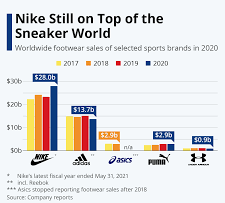
Nike’s Just Do It: Marketing Strategy
Brand Identity and Slogan: Just Do It
Nike unveiled its legendary “Just Do It” slogan in 1988, marking the inception of one of the most iconic and long-lasting marketing campaigns globally. This slogan embodies Nike’s fundamental brand message of empowerment, inspiring individuals to surmount challenges and realize their aspirations. Its universal appeal has struck a chord with a wide-ranging audience, spanning from athletes to ordinary people, fostering a sense of motivation and determination.
Buying products endorsed by athletes serves as a symbolic and public display of one’s desire to belong to a particular group. This behavior is directly influenced by how much a fan identifies with the athlete endorser. Advertising themes centered around heroes and hero worship, exemplified by celebrity endorsements like Bo Jackson, John McEnroe, and Michael Jordan, resonated with consumers by appealing to their sense of belonging and trendiness. Essentially, American consumers were convinced that wearing Nike products was both intelligent (due to their comfort) and trendy (because everyone else was wearing them, suggesting belonging to an exclusive group).
The success of the “Just Do It” campaign can be attributed to its ability to captivate customers on two fronts. Firstly, wearing Nike products became a statement of self-fulfillment—a declaration that if you’re cool, you’re likely wearing Nike. Secondly, it created a desire by suggesting that if you want to be cool, you should wear Nike. This strategy significantly boosted Nike’s share of the domestic sport shoe market in America, jumping from 18 percent to 43 percent and reclaiming its position as the market leader.
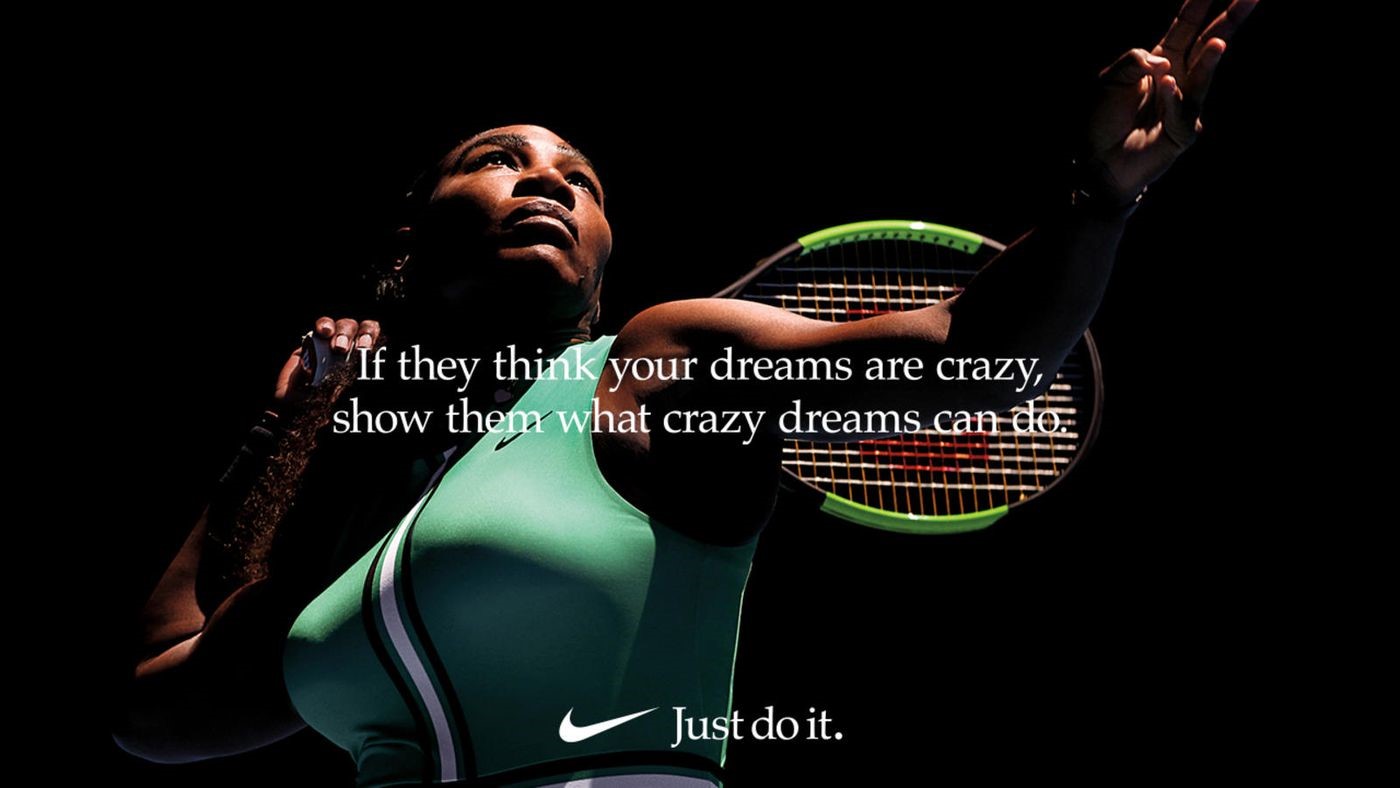
Celebrity Endorsements
Nike has a rich tradition of collaborating with elite athletes, celebrities, and sports teams, forming a cornerstone of their marketing approach. Renowned sports icons like Michael Jordan, Serena Williams, LeBron James, and Cristiano Ronaldo have all forged partnerships with Nike. Through these associations, Nike not only enhances its credibility and authenticity but also extends its reach to a wider audience.
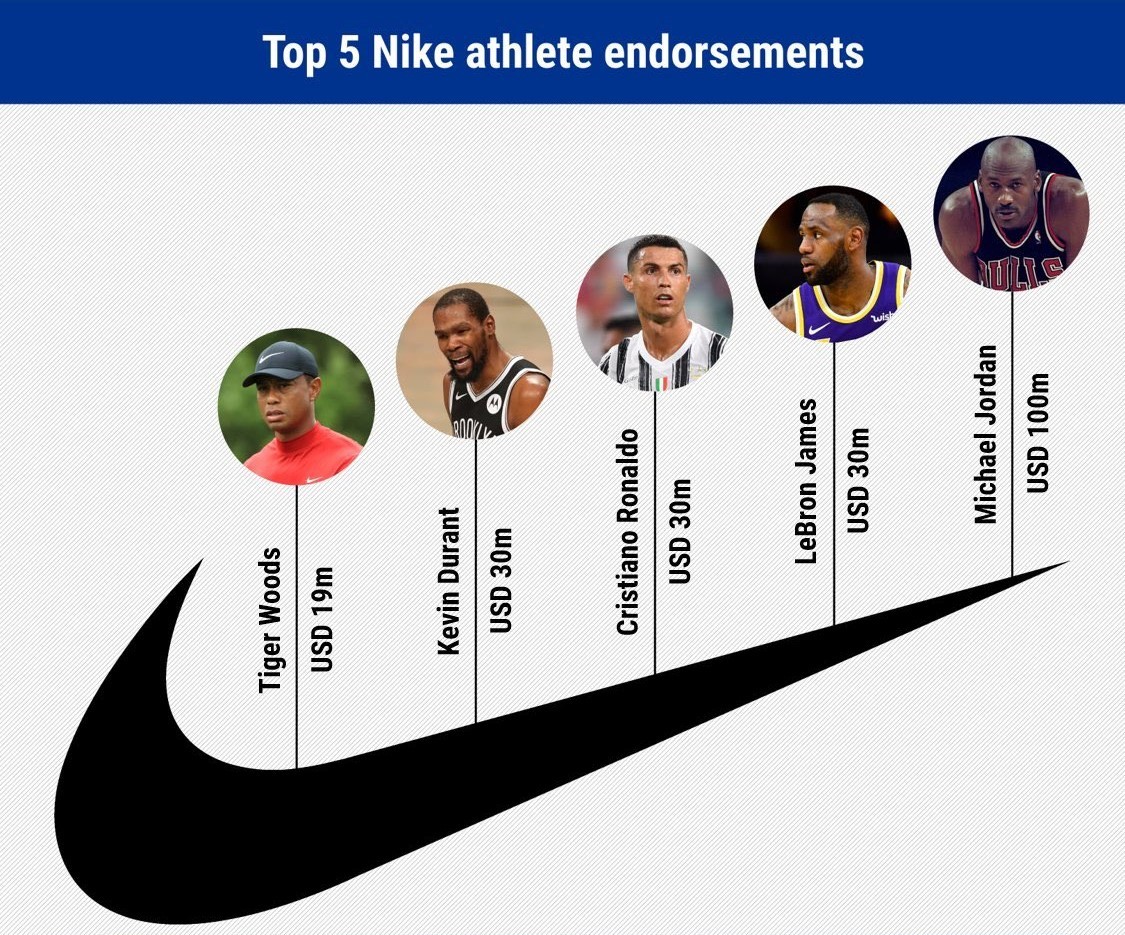
Creative Product Advancement
Nike consistently dedicates resources to advancing product development and innovation. They have pioneered groundbreaking technologies such as Nike Air, Flyknit, and Dri-FIT, all designed to elevate the performance and comfort of their offerings. This commitment to innovation guarantees that Nike remains at the forefront of sportswear and athletic footwear.
Digital Marketing and Social Media
In today’s digital landscape, Nike has mastered the art of utilizing social media to interact with its customer base. Platforms such as Instagram, Twitter, and Facebook serve as invaluable tools for Nike to reach and engage with a vast online audience. Through these channels, Nike shares inspiring content and showcases its products. Additionally, Nike has introduced dedicated apps like Nike+ Run Club and Nike Training Club, providing further support and encouragement to consumers striving to meet their fitness objectives.
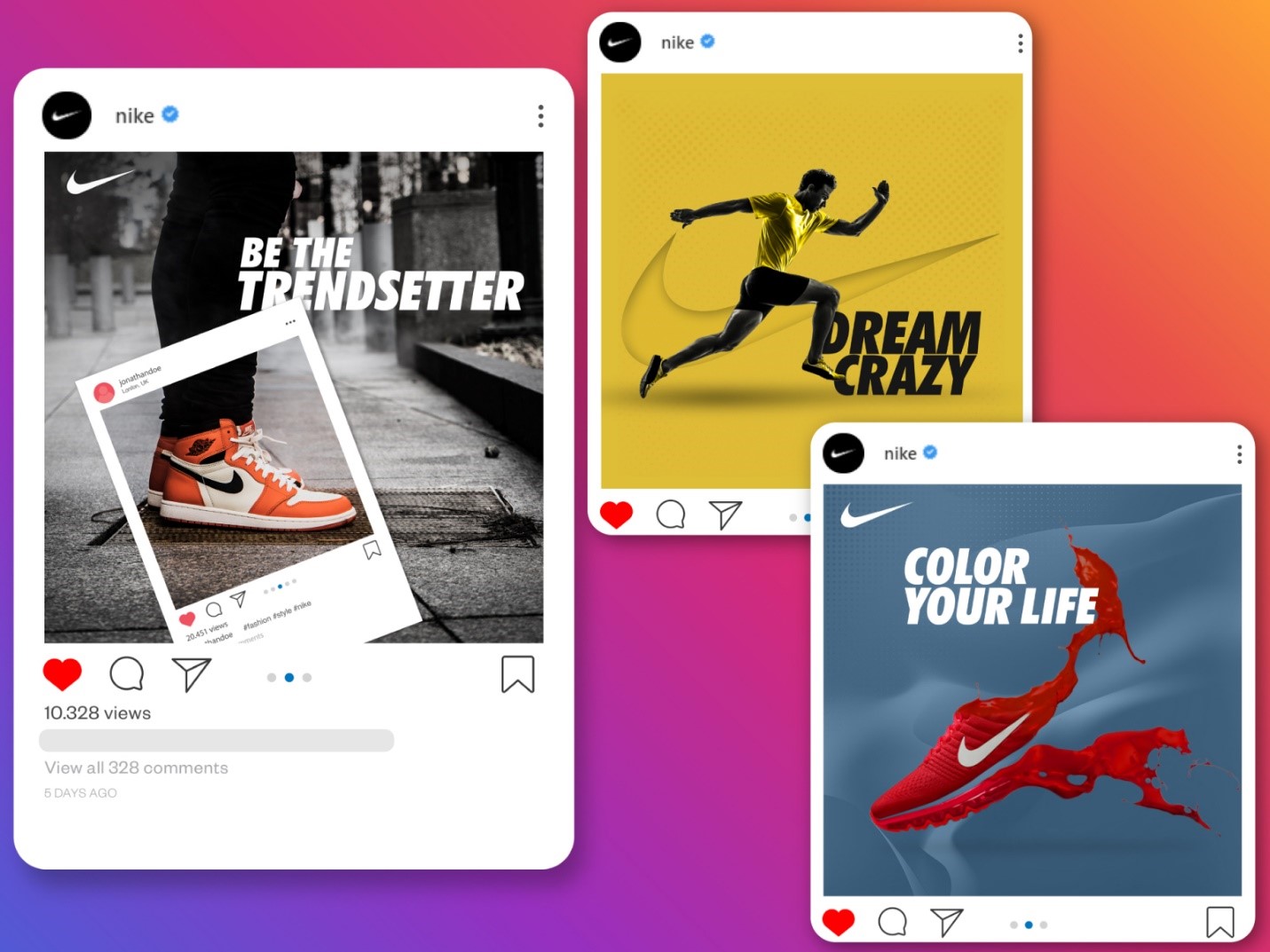
Grassroots Marketing
Aside from collaborating with famous celebrities, Nike maintains a strong connection with its origins within the athletic community. They support a multitude of local and national sports events, as well as grassroots initiatives and youth programs. This grassroots marketing approach ensures that Nike stays engaged with athletes from various levels and backgrounds.
Diversity and Inclusivity:
Nike has embraced a firm commitment to diversity and inclusivity. Their marketing campaigns frequently highlight and celebrate diversity while also challenging stereotypes. By addressing social and cultural issues, Nike has successfully connected with a younger demographic that values social consciousness.
Results:
Nike’s marketing strategy has been a cornerstone of its success, evidenced by several key outcomes:
Market Dominance: Nike stands as the unrivaled leader in the global sportswear industry, consistently surpassing competitors.
Revenue Growth: Nike’s revenue has seen continuous growth, surpassing $40 billion in 2021, reflecting its strong market position.
Brand Loyalty: The impactful “Just Do It” campaign and strategic celebrity endorsements have cultivated a deep emotional connection with consumers, fostering unwavering brand loyalty.
International Expansion: Nike’s global footprint has expanded significantly, particularly in emerging markets like China, indicating its ability to adapt and thrive in diverse cultural contexts.
Digital Engagement: Nike’s robust digital presence and innovative apps have enabled direct interaction with consumers, facilitating a more personalized and engaging experience.
In sum, Nike’s marketing strategy has been pivotal in establishing it as one of the most prominent and successful brands globally. Through a combination of brand identity development, celebrity partnerships, innovation, and digital marketing prowess, Nike continues to lead the pack, inspiring athletes and consumers worldwide with its iconic “Just Do It” philosophy.
Nike Mission, Vision & Values
Nike Mission Statement
A company’s mission statement encapsulates its immediate objectives and outlines the focus areas needed to achieve them. Nike’s mission is succinctly captured in the statement “to bring inspiration and innovation to every athlete in the world.”
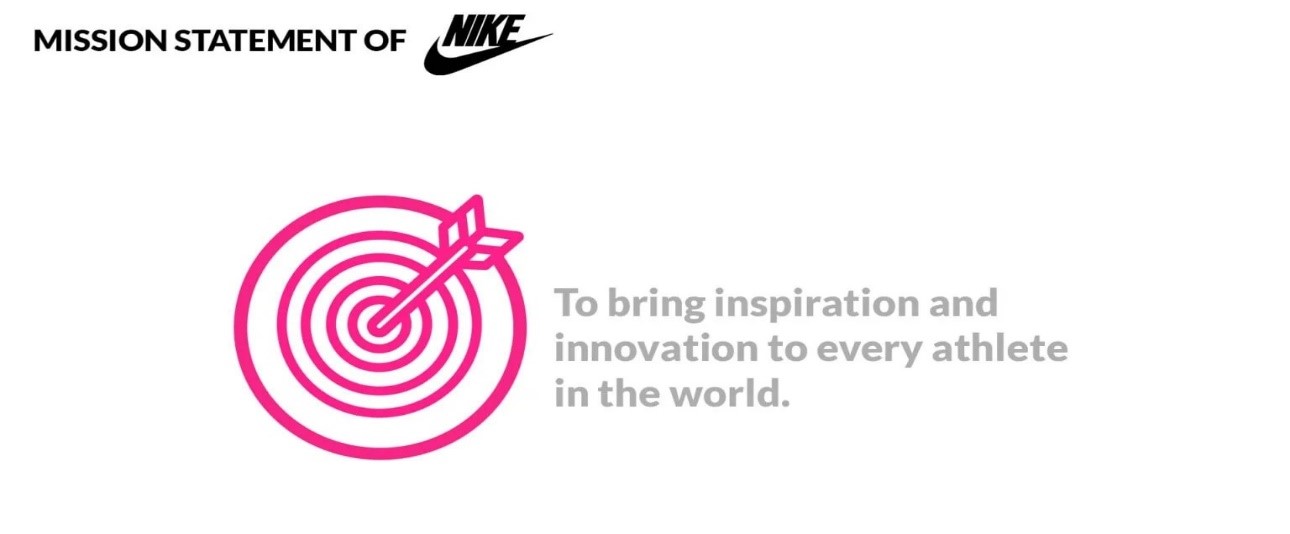
Breaking down this mission reveals three fundamental elements: inspiring individuals, fostering innovation, and supporting athletes worldwide. Let’s delve into each component to grasp the essence of Nike’s mission.
Inspiring Individuals:
Nike’s iconic slogan “Just Do It” epitomizes this aspect perfectly. Through this simple yet powerful phrase, the company motivates athletes of all levels to surpass their boundaries and unlock their full potential. Nike’s strategic use of prominent sports figures as role models empowers ordinary individuals, particularly the youth, encouraging them to embrace sports and challenge their personal limits.
Fostering Innovation:
Nike continuously pioneers groundbreaking innovations across its product range, enabling individuals to enhance their athletic performance and achieve unprecedented feats. A notable example is Nike’s ambitious endeavor to facilitate a sub-two-hour marathon, a feat previously deemed unattainable. Despite skepticism, Nike’s relentless research and development efforts culminated in the creation of highly innovative running shoes that propelled Kenyan runner Eliud Kipchoge to break the barrier with a remarkable time of 1:59:40.
Supporting Athletes Worldwide:
Nike’s co-founder Bill Bowerman famously proclaimed, “if you have a body, you are an athlete.” This ethos underscores Nike’s belief that everyone possesses an innate athletic potential, regardless of professional status or inherent talent. As such, Nike designs sports apparel, footwear, and equipment catering to a diverse clientele. Embracing inclusivity, the company offers a comprehensive range of products tailored to athletes of varying skill levels, body types, and aspirations.
Nike Vision Statement
The vision statement of a company outlines its aspirations for the future, portraying an idealized image of what the company aims to become. Nike’s vision statement, “to remain the most authentic, connected, and distinctive brand,” emphasizes the company’s commitment to maintaining its current position as a leader in the global sporting goods industry.

This statement acknowledges Nike’s acknowledgment that it has already achieved status as the foremost brand in authenticity, connectivity, and distinctiveness within its industry. This self-awareness reflects the company’s intention to sustain this position. Given Nike’s evident dominance in the market, reinforced by market data, the vision statement underscores its determination to preserve its top-tier status.
Authenticity:
Nike has established itself as authentic through its consistent delivery of high-quality products and services that exceed customer expectations. Its focus extends beyond mere profit generation to empowering individuals and enhancing human potential through its offerings.
Connectivity:
Nike’s marketing strategies are designed to foster and maintain strong personal connections with its consumers. Since its inception, the company has prioritized people and their well-being, reflected in various initiatives supporting different segments of society. This approach enhances Nike’s relatability and fosters positive connections with its target market.
Distinction:
Nike’s journey to the top involved overcoming numerous challenges and significant investments, resulting in its status as the most distinctive brand in athletic shoes and apparel today. Its globally recognized logo and slogan epitomize its distinctiveness. Market reports further substantiate Nike’s brand value, far surpassing that of its closest competitor, Adidas.
In essence, Nike’s vision statement encapsulates its commitment to maintaining its authenticity, connectivity, and distinctiveness, ensuring its continued leadership in the sporting goods industry.
Nike’s Core Values
Nike’s core values reflect its priorities, emphasizing continuous growth and excellence in the sports industry. This commitment to advancement can be further delineated into four key aspects.
Community:
Nike values unity and teamwork akin to that of a sports team. Each member contributes equally, fostering a collaborative environment where individual efforts are recognized and valued in pursuit of shared objectives.
Sustainability:
Despite being lesser-known, Nike actively engages in environmental initiatives, such as repurposing plastic bottles to create sustainable footwear through its innovative Flyknit technology, showcasing its dedication to environmental sustainability.
Diversity:
Nike boasts a diverse and creative global team, contributing to its widespread presence and appeal across different demographics worldwide. Its inclusive approach ensures that Nike products resonate with individuals of varied ages, backgrounds, and athletic interests.
Social Responsibility:
In addition to pursuing its corporate goals, Nike remains steadfast in its social responsibilities. Through initiatives promoting environmental awareness and conservation, alongside various programs advocating for positive social change through sports, Nike demonstrates its belief in the transformative power of athletics for societal betterment.
SWOT Analysis of Nike
Here’s a detailed breakdown of Nike SWOT analysis.
Nike’s Strengths
Strong Brand Awareness and Brand Value
Nike stands out as a globally renowned brand, distinguished by its easily memorable name and universally recognized swoosh symbol. The Interbrand global brand ranking report underscores Nike’s prominence, positioning it at an impressive #9 with a remarkable brand value of $53.7 billion.
Huge Customer base
Nike boasts a vast customer base spanning the globe, comprising millions of loyal followers who eagerly embrace Nike’s latest trends, actively engage in Nike-sponsored events, and willingly offer valuable feedback. Such widespread popularity has propelled Nike’s market capitalization to an impressive $142.2 billion as of March 2024.
Aimed For Sustainability
Nike’s CEO, Mark Parker, has committed to addressing environmental concerns within communities, affirming the company’s dedication to contributing towards solutions for these pressing issues.
Low Manufacturing Cost
The majority of Nike’s footwear is produced overseas. In the fiscal year 2023, Vietnam accounted for 50%, Indonesia for 27%, and China for 18% of Nike’s total footwear production. Additionally, Nike operates manufacturing facilities in other countries including Argentina, Brazil, India, Italy, and Mexico.
Outstanding Marketing Expertise
Nike demonstrates remarkable prowess in marketing, leveraging various strategies to bolster its brand presence. The company heavily invests in demand creation expenses, encompassing advertising, promotions, endorsement deals, media placements, and complimentary product offerings. Over the fiscal years 2021, 2022, and 2023, Nike allocated $3.1 billion, $3.8 billion, and $4.06 billion respectively towards these endeavors. Through adept utilization of social media platforms and impactful marketing campaigns, Nike effectively expands its reach to target a broader customer base.
Support for the Black Community
Nike showcases its marketing acumen through initiatives such as the “Don’t Do It” ad campaign, demonstrating solidarity with Black communities in the fight against racism.
Dominant Market Position
Nike reigns supreme as a frontrunner in the footwear industry, boasting a commanding market share. The company has secured approximately 39% of the global athletic footwear market and 13% of the global athletic apparel market, solidifying its position as a market leader.
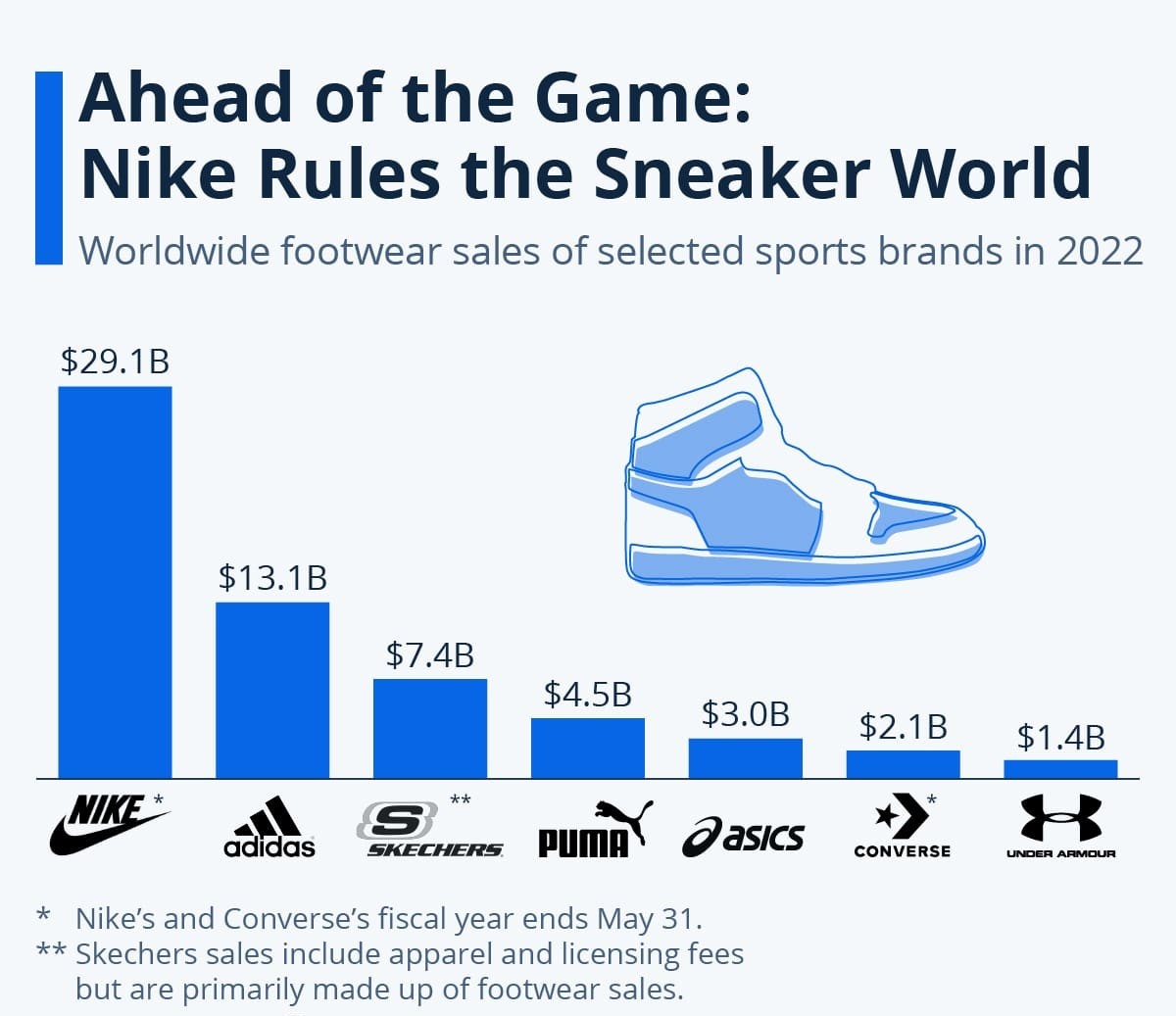
Nike’s Weaknesses
Concerns Over Substandard Labor Conditions Overseas
Over the past two decades, Nike has faced persistent scrutiny regarding its labor practices in foreign countries. Allegations have surfaced, pointing to instances of forced labor, child labor, inadequate wages, and unsafe working environments.
Retailer Dominance Weakens Nike’s Position
Nike’s heavy reliance on retailers for product distribution exposes the company to vulnerabilities, particularly concerning pricing dynamics. A significant portion, accounting for 56%, of Nike’s products are sold directly to wholesalers or retailers. As a result, Nike finds itself in a weakened position, lacking the leverage to challenge or negotiate pricing structures imposed by retailers.
Conflicting Approaches
Nike has committed to transitioning all its facilities to 100% renewable energy with net-zero carbon emissions through its “Move to Zero” initiative. While this move is commendable, it appears at odds with Nike’s historical emphasis on innovation over sustainability. This perceived contradiction raises doubts about Nike’s genuine commitment to addressing climate change, leading some to view its pledge as merely a superficial marketing tactic.
Reliance on the North American Market
Despite its global stature, Nike remains heavily dependent on the North American market for sales and revenue. In the fiscal year 2023, approximately 44% of Nike’s sales were generated in North America, with the remaining 56% attributed to global sales. Despite its widespread popularity and presence, Nike’s growth and revenue still hinge significantly on the U.S market.
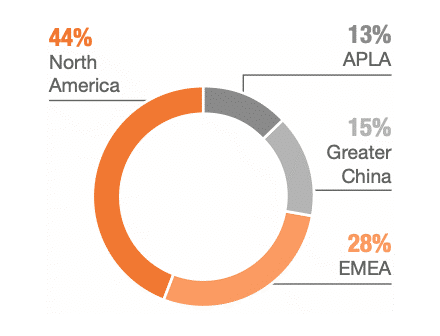
Instances of Sexual Harassment
Former female employees have come forward, shedding light on prevalent instances of sexual harassment and misconduct within the company. A comprehensive investigation conducted by The New York Times involved interviews with 50 current and former Nike employees, revealing a toxic work culture where sexual misconduct was widespread.
Numerous female employees disclosed their experiences of raising concerns with HR regarding harassment, only to find that no effective action was taken in response. These women were left feeling disillusioned and unsafe in their workplace, with some ultimately opting to leave their positions at Nike. The fallout from this controversy has severely tarnished the company’s reputation.
Pending Debts
While Nike’s income statements reflect strong profitability, a closer examination of its balance sheet reveals ongoing financial challenges. Despite its apparent success, Nike remains burdened by significant financial obligations. As of fiscal year 2023, the company’s total long-term debt amounted to $8.9 billion.
Nike’s Opportunities
Untapped Opportunities
While Nike maintains a global presence, significant growth prospects still lie ahead, particularly in emerging markets such as India, China, and Brazil, where economic development is steadily expanding.
Innovation Potential
Despite a diverse product portfolio, Nike continues to explore avenues for innovation, particularly in the realm of technology. Ventures into wearable technology, which monitors physical activity, exemplify Nike’s foray into novel product categories. The integration of technology with athletic apparel remains an underexplored domain within the fashion industry, presenting ample opportunities for Nike’s innovation.
Enhanced Integration
Nike’s supply chain relies heavily on independent manufacturers. To bolster efficiency and streamline operations, the company could consider acquiring some of these manufacturers or establishing its own production facilities, facilitating a more integrated and efficient supply chain.
Consumer Direct Strategy
Nike has expedited its consumer-direct strategy, pivoting towards digital channels and consequently shuttering physical retail locations. In fiscal year 2023, a notable 44% of Nike’s revenue is attributed to online sales, highlighting the profound impact of the pandemic on Nike’s customer engagement strategies.
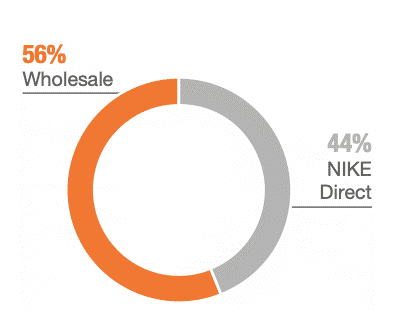
Investments in Innovation
Utilizing its substantial financial resources, Nike has engaged in acquiring small to medium-sized companies or startups. A recent acquisition includes the predictive analytics platform Celect, aimed at bolstering Nike’s online sales capabilities and enhancing its ability to forecast customer shopping behavior.
Venturing into the Metaverse
In a strategic move, Nike has acquired RTFKT, a digital shoe-making company, signaling its entry into the virtual realm. RTFKT specializes in designing shoes exclusively for the digital domain. However, an interesting development emerged as RTFKT announced a collaboration with FEWOCiOUS, a young artist, to sell real shoes alongside their digital counterparts. Nike is poised to capitalize on the burgeoning market within the Metaverse, where users can leverage their Metamask wallets to purchase various in-game merchandise, including digital footwear.
Nike’s Threats
Challenges from Counterfeit Products
Nike faces a significant risk from counterfeit products, which pose a threat to both its revenue streams and brand reputation. As a global entity, Nike operates in regions where counterfeit goods are prevalent, leading to the proliferation of fake Nike merchandise offered by various retailers at discounted prices.
These counterfeit items, though cheaper, are often crafted from inferior materials yet bear the Nike brand label. Such practices can erode the brand’s image, as consumers may perceive Nike as producing substandard products.
Heightened Competition
Despite Nike’s dominance in the athletic industry, the landscape remains fiercely competitive, with emerging brands like On and Hoka presenting potential challenges. This heightened competition compels Nike to allocate substantial resources towards marketing and advertising efforts, amounting to $4.06 billion dedicated to marketing and demand generation in fiscal year 2023. To maintain its competitive edge, Nike must focus on designing innovative products tailored to the specific needs of athletes.
Marketing Budget Pressures
Rival companies such as Under Armour, Adidas, and Lululemon are intensifying their marketing and advertising expenditures, further exacerbating the pressure on Nike. This necessitates strategic allocation of resources and innovative marketing approaches to effectively navigate the competitive landscape.
Economic Instability
Irrespective of industry, companies are vulnerable to the adverse impacts of a global economic downturn. Nike witnessed a decline in sales during lockdown periods, and further sales reduction could occur in the event of a severe recession, as predicted by experts.
Trade Frictions
Nike’s reliance on various global markets, particularly highlighted by increased stock performance driven by sales growth in China, exposes the company to risks associated with trade tensions. Given that China and the US represent Nike’s largest markets, escalating trade disputes between these economic powerhouses could jeopardize a significant portion of Nike’s sales.
Patent Disputes with Adidas
Nike has filed a complaint with a US agency alleging that Adidas infringed upon its Flyknit shoe technology patent, claiming that Adidas incorporated Nike’s technology into 49 shoe designs utilizing Primeknit technology. Adidas has countered these claims, asserting that its Primeknit technology was developed independently after years of research and development.
Concerns Regarding Kangaroo Population
Nike faces accusations of endangering the Australian kangaroo population by utilizing kangaroo skin in the production of leather football shoes. Animal rights activists have called on Nike to reconsider its sourcing practices and explore plant-based alternatives. Despite these allegations, Nike has yet to address the issue publicly.
Rising Incidents of Retail and Warehouse Theft
Nike grapples with a surge in theft incidents across its supply chain, encompassing warehouse and retail thefts. The National Retail Foundation reports that retail theft has become a pervasive issue in the United States, estimated to cost the industry approximately $95 billion.
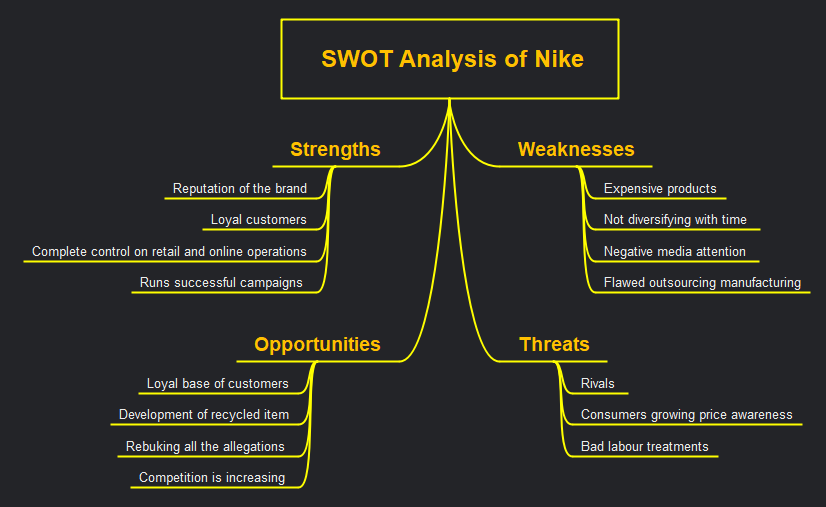
Summary
In summary, Nike has effectively articulated its mission and vision, laying a strong foundation for its ongoing success in the sportswear industry. This clear and compelling message has propelled Nike to unparalleled heights, solidifying its position as a dominant force in the market. By adopting an efficient business model focused on delivering inspirational and innovative products, Nike has sustained steady growth in both scale and influence.




